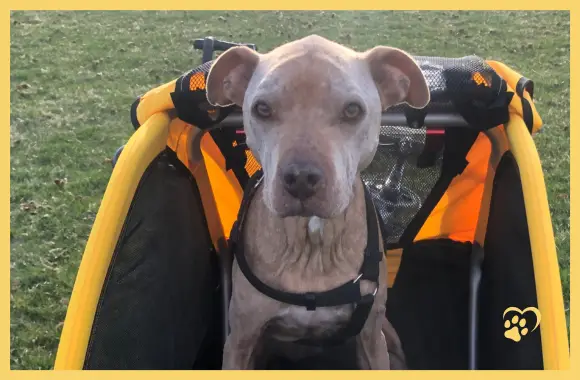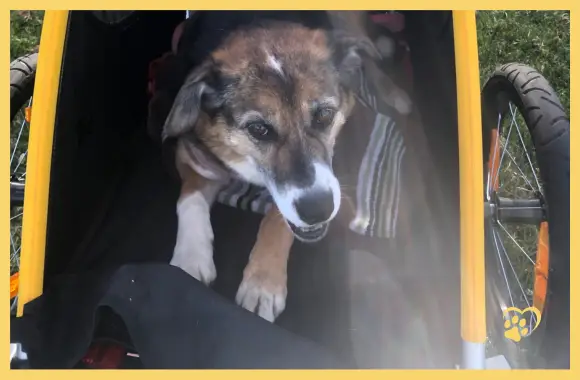Imagine cycling through the fresh morning air. The sun tickles your nose and the chirping of birds fills the silence. But something is missing: your favorite dog! How about having him by your side, safe and comfortable in a bike trailer? Whether you're planning a relaxing weekend bike ride or simply looking for a way to safely take your dog along on longer trips, a bike trailer can be the perfect solution.
We show you how to get your dog used to a bike trailer. Step by step, we'll guide you through the process - right down to tips for long bike rides. So that your next outing will be a complete success!
Things to know about bicycle trailers
What exactly is a bicycle trailer?
Imagine a small, comfortable cart that you can attach to your bike. With a bike trailer, you can transport your dog safely and comfortably. A bike trailer attaches easily to most bicycles and gives your dog plenty of room to sit, lie down and even run.
The right choice: the right bike trailer for your dog
When choosing a bike trailer, the size is crucial. Your dog should have enough space to lie down and sit. It is also important that the trailer is made of sturdy, water-repellent material and is well ventilated. A padded interior and adjustable harnesses are other pluses to make the ride as comfortable as possible for your dog. Some models even have windows so your dog can enjoy the view!
Safety first: What you should look for in a bicycle trailer
Safety first. Make sure that the trailer has a well-functioning braking system. Reflectors or light strips improve visibility in low light conditions. Good suspension ensures that your dog has a comfortable ride, even on uneven surfaces. Make sure your dog is well secured and cannot jump out during the ride.
All in all, a bike trailer is a great way to take your dog along on your bike tours. This way, you can adventure together and discover new places without overwhelming your four-legged friend. With the right trailer and a few safety precautions, you'll be ready to conquer the road!
Read also: 7 things you need to know before buying a bike trailer for your dog
The first steps: Getting the dog used to the trailer
Introduction of the trailer in a safe place
Your dog will probably react suspiciously to the new trailer at first - this is quite normal! The first contact should therefore take place in a place where your dog feels comfortable, for example in your living room or garden. Let your dog sniff the trailer in peace. Open the door of the trailer and allow your dog to approach at his own pace. Do not push him, but allow him time to become familiar with the new situation.
Create positive associations
In order for your dog to perceive the tag as something positive, you should associate positive experiences with it. Put some treats or your dog's favorite toy in the trailer. You can also try moving feeding times to the trailer. Start with the food bowls near the trailer and gradually move them into the trailer. Praise your dog every time he approaches or enters the trailer.
It is important that you do not force your dog to go into the trailer. Let him choose to do so voluntarily. With patience and positive associations, your dog will soon become curious and see the trailer as a place where there are treats, fun and attention! Remember, this is a process that takes time. Every small success is a step in the right direction. Before you know it, your dog will be ready for his first ride!

The first rides with the bike trailer
The first steps: encouragement and patience
Once your dog has become familiar with the trailer, it's time for the next step. Attach the trailer to your bike and encourage your dog to get on. Leave the leash on at first to have more control. It is important to always give your dog enough time to get used to the new situation. A gentle, encouraging tone and lots of patience are crucial.
Short walks at the beginning: slowly increase duration
Start with short rides near your home. These short "test drives" will help your dog get used to moving around in the trailer. Gradually increase the duration and distance of the trips. Don't forget to stop and praise your dog repeatedly during the ride. That way he knows he's behaving well!
Reward positive behavior
Always praise and reward your dog when he sits in the trailer and stays calm. Whether it's verbal praise, petting, or treats, positive reinforcement helps your dog understand that he's behaving correctly. Over time, your dog will learn that rides in the trailer are a positive thing, and he will look forward to it.
Getting your dog used to a bike trailer is a gradual process that requires patience and empathy. Every dog is different and some need more time than others. The most important thing is that your dog feels safe and comfortable. With love, patience and regular training, your dog will soon be ready to join you on new adventures on wheels!
How to maintain the progress of your dog
Remain constant
To solidify your dog's positive experience with the bike trailer, consistency is key. Build short rides into your daily routine to show your dog that the trailer is a normal part of his life. Regular training will help your dog become more confident and comfortable in the trailer.
Slow increase in travel distance
Once your dog is comfortable on short walks, you can begin to slowly increase the distance and duration of the walks. As with any training, it is important to increase the difficulty level slowly so as not to overwhelm your dog. Remember to always take enough breaks and provide your dog with water and snacks along the way.
How to deal with setbacks
It's normal to have setbacks as your dog gets used to the bike trailer. Perhaps one day your dog is fearful or unwilling to get into the trailer. In such cases, it is important to remain calm and patient. Do not force your dog, but give him time and space. A setback does not mean that your training has failed. Often your dog just needs a break or a little more time to adjust.
Success doesn't happen overnight, and that's a good thing. With consistency, patience and understanding, you can help your dog make riding in a bike trailer a positive and enjoyable experience.
Adventure calls: Tips for longer bike tours with dog
Plan for longer tours
A well-planned packing list can make the difference between a memorable adventure and a stressful experience. Make sure you have enough water and snacks for your dog. A travel blanket, toys and a spare leash are also useful. And don't forget the poop bags to keep nature clean!
Safety measures during the trip
Safety always comes first. Make sure your dog is securely fastened in the trailer before you start driving. Check regularly to make sure all parts of the trailer are properly secured and working properly. In warm weather, avoid the hottest hours of the day so your dog does not overheat.
How to take into account the needs of your dog while driving
It is important to read your dog's signals and respond to his needs. If he is restless or whining, he may need a break or something is wrong. Schedule regular breaks so he can relieve himself and stretch his legs. And remember to have plenty of water with you during the ride.
Longer bike rides with your dog can be a great way to explore the world together. With the right preparation and safety precautions, you and your dog can travel safely and happily.

Detailed packing list for a bike tour with dog
- Water bowl and enough water: Your dog will be thirsty during the ride, especially on hot days. Foldable water bowl takes up little space and is easy to carry.
- Snacks and food: If you are traveling for a long time, take enough food for your dog.
- Leash: Even if your dog is in the trailer, you need a leash for breaks and emergencies.
- Toys or chewing articles: These can keep your dog busy and calm during the ride.
- Ceiling: A soft blanket makes the trailer more comfortable and gives your dog a familiar smell.
- Feces bag: To keep the environment clean, you should always have enough poop bags with you.
- First aid kit: Includes bandages, tweezers, blanket, fever thermometer, disinfectant and any special medications for your dog.
- Rain cover: In unexpected weather, a rain cover for the trailer can be very useful.
- Spare line: In case the main line breaks or is lost, it is always good to have a spare line with you.
- Sunscreen: Dogs can also get sunburned, especially those with fair skin and short fur. Sunscreen specifically for dogs can help protect their sensitive skin.
This list can be adjusted depending on the duration of the outing, the weather and your dog's individual needs. It is always better to be well prepared when you are out with your dog.
Read more on the subject of bicycle trailers:
- 7 things you need to know before buying a bike trailer for your dog

- Are bike trailers for dogs right for you? Advantages and disadvantages at a glance

At the end
Cycling with a dog has many advantages. It allows you to cover long distances, explore the countryside and discover new places while keeping your dog safe and comfortable. It's also a great way to give your dog exercise and stimulation without overwhelming him.
As with any new experience, your dog will need time to get used to the bike trailer. It is important to be patient and consistent and reward every positive interaction your dog has with the trailer. With time and practice, your dog will find the trailer a safe and enjoyable place to be and your bike rides together will become a real pleasure.
Getting your dog used to a bike trailer is a process that takes time and patience. But the joy and shared experiences you will have are more than worth the effort.
